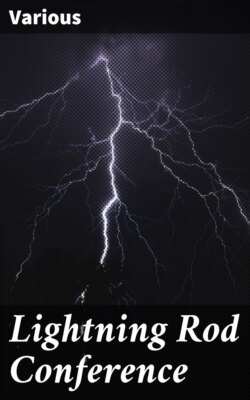Читать книгу Lightning Rod Conference - Various - Страница 19
На сайте Литреса книга снята с продажи.
2. The Material and Dimensions of the Conductor.
ОглавлениеTable of Contents
The use of copper is almost universal, but two manufacturers occasionally use iron. The form varies. The majority use wire rope, but some use rods, others bands or tapes, others tubes. One firm uses a cable “constructed of 49 strands of hard-drawn square copper wire.” Another firm uses a wire rope, simply because “it appears to be an open question, at present, whether it is surface or mass which conducts.” The dimensions are as varied as the form, from a wire rope ⅜th of an inch in diameter to a copper band 3 inches wide and ⅛th thick.
The only point worthy of note is, that no one uses a smaller conductor than a copper rope ⅜th in diameter (i.e. 4 oz. of copper per foot run).
Leaving the dimensions as a question for future investigation, the points submitted for the consideration of the Conference under this head are—
1. Is conduction a question of surface or of mass?
2. Is copper alone to be used?
3. Is the conductor to be in the form of a rope, a rod, a tube, or a band?
Now, on the first point the writer entertains no doubt whatever that the conduction of atmospheric electricity is simply a question of mass, and that the lightning protector acts simply as a conductor obeying the laws of Ohm.
On the second point he sees no objection whatever to the use of iron, when properly galvanized, in situations free from chemical impurities. The reasons urged against its adoption are extremely weak. First, it is said to decay rapidly; and, secondly, it is said to be a very much worse conductor than copper.
The rusting of iron is almost entirely checked, in pure air, by galvanising or coating with zinc. It is used for nearly every other purpose in connection with building, and it is difficult to understand why it should be discarded on account of its liability to decay for this particular purpose, where it is always under supervision.
Again, pure copper conducts about six times better than pure iron: but we never get pure copper in lightning conductors. Moreover, the manufacture of iron wire for telegraphic purposes has increased so enormously during the last two or three years, that the wire now supplied conducts 50 per cent. better than it used to. Hence the difference between the two in this respect is not so great as theory indicates; and it would be well for the Conference to satisfy itself on this point by having similar sized wires made of the two materials, and having them measured electrically for their resistance.
But it has been pointed out by the late Mr. Brough (Phil. Mag., May, 1879), that by regarding (1) the influence of the rise of temperature, (2) the difference between the specific heats, and (3) the relative dimensions, iron conductors can be made much smaller than was formerly supposed: and, that as iron is so much cheaper, iron rods can be made equally efficient for a much less sum than copper. Moreover, the use of iron enables the architect to use one kind of metal throughout his structure, and thus avoid anywhere the contact of dissimilar metals, which always results in decay.
On the third point, the writer is clearly of opinion that a galvanized iron rope is amply sufficient for country residences and buildings free from chemical actions. In such places, and in towns, copper should be used. A rope, whether of iron or copper, is easily handled, it can be made of any size, it can be led in any direction without bends or angles, it is neat and easily jointed, diverted, or lengthened.
The writer refrains from expressing any opinion on its dimensions here, for this is a point that will require most careful examination by the Conference.
